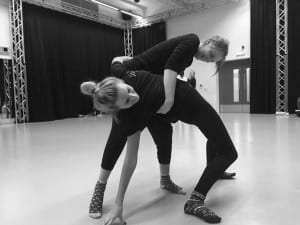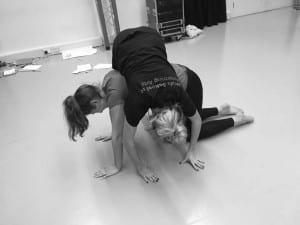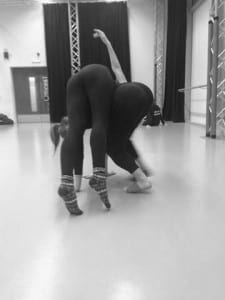This week was again a contact research lab, giving us the opportunity to explore a topic of interest. I was in a group with Emma, Robyn and Chloe and collectively we agreed that the transformation between levels was something we all struggled with. When being involved in a contact improvisation,we felt that rather than it be something which happens naturally moving from floor to standing, it is as though we give too much thought in to the process which results in one person normally taking control and pulling the other person up.
The question which we formed was:
‘How can we transition through levels without just standing or falling through them?’
From this question, we then choose three different factors to structure our investigation. These included:
Having a time limit: With only two people dancing at one time, the others watching would choose a time limit for the transition from low level to standing. When i was dancing i discovered the difference between speed. If we were moving quickly we would rush the transition and would not stay in contact. However, the longer the time limit, the more interesting the transition would be and the more complex. This was also the same from standing to a lower level, i found that we both seemed to just almost drop to the floor.
After our discovery from having a time limit we then formed another factor:
Finding the most complex transition: This was interesting, because it enabled us to naturally find new and effective ways of lifting each other to standing and finding our way to the floor. By ensuring that we wern’t taking the simplest route, it also encouraged fluidity and we able to continiously move for longer. Sometimes if you use the simplist route, it can restrict movement.
Connecting two specific body parts for the transition: The body parts which we connected included: Stomach to stomach, knees to knees, back to stomach, back to back, and head to head.
The results from this task were quite suprising. Before we did the task, we believed that stomach to stomach would create a good transition, however we figured from the investigation it was probably one of the hardest points of contact as we were both pushing against each other therefore none of us were a stable base. We found that moving with our heads connected worked really well because it didn’t restrict any movement from the rest of our bodies and we were still able to move around freely.
At the end of our jam session we came up with the following questions which we could answer in order to help us to understand our findings:
- How can we transition through levels instead of using the simplest route?
- How can lifts be incorporated when travelling through levels?
- How does facing different directions change the role of the under and over dancer?
- How does a time limit change the complexity of the movement?
This week i did find really useful, because it made me aware that sometimes i do just use the most available body part, rather than experimenting more with others which i do not use as much. I found interesting and creative transitions by trying to use the most complicated route, so i will try and bring this skill in to class.




